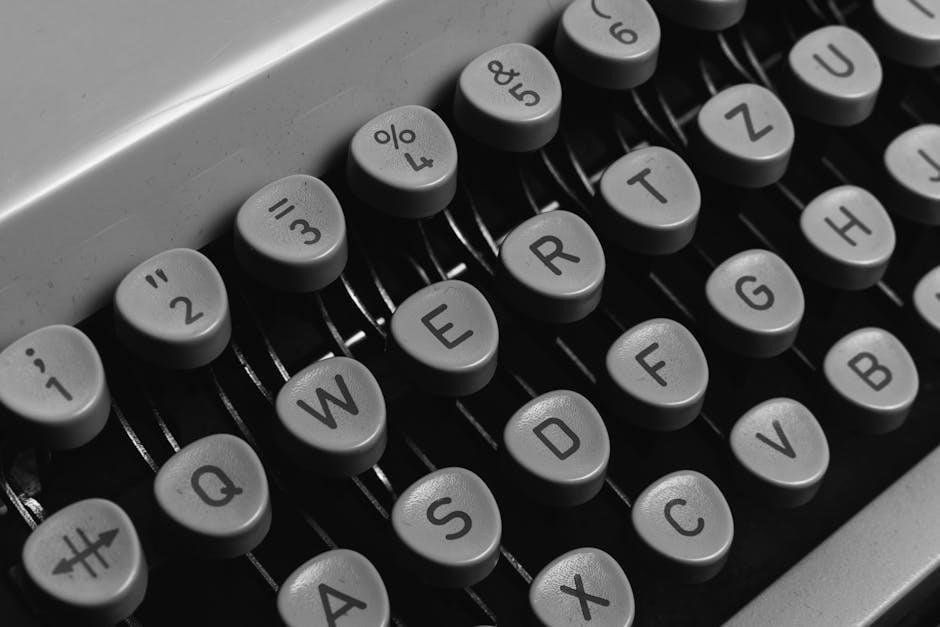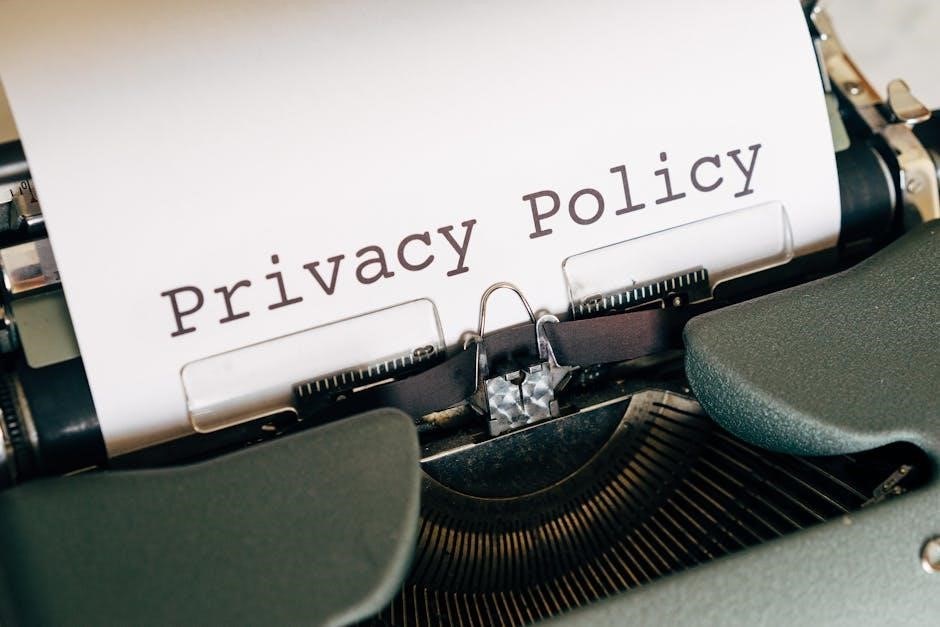
The Department of the Navy Correspondence Manual establishes standardized procedures for preparing and managing official correspondence across all Navy commands, ensuring clarity and efficiency in communication.
1.1 Overview of the Manual’s Purpose and Scope
The Department of the Navy Correspondence Manual provides uniform standards for managing and preparing official correspondence. It ensures consistency, clarity, and professionalism in all written communications. The manual applies to all Navy commands and activities, outlining proper formatting, style, and procedures. It covers topics such as classified information handling, record-keeping, and electronic communication protocols. By standardizing correspondence practices, the manual enhances operational efficiency and compliance with regulatory requirements, ensuring effective communication across the Department of the Navy.
1.2 Importance of Standardized Correspondence in the Navy
Standardized correspondence is critical for maintaining professionalism, clarity, and consistency in Navy communications. It ensures that all official documents are presented in a uniform format, reflecting the Navy’s commitment to precision and discipline. Properly formatted correspondence enhances readability, reduces misunderstandings, and promotes efficiency in decision-making. Adherence to these standards also supports compliance with legal and regulatory requirements, safeguarding sensitive information, and upholding the Navy’s reputation. Uniformity in correspondence is essential for effective communication across all levels of command, ensuring operational success and alignment with the Department of the Navy’s mission and values.

Structure and Organization of Naval Correspondence
Naval correspondence follows a structured format, ensuring clarity and professionalism. It includes key elements such as headings, subject lines, references, enclosures, and the body, organized to facilitate efficient communication. Margins, alignment, and font size are standardized, with specific guidelines for classified or sensitive information. Proper organization ensures that correspondence is easily understandable, meets regulatory requirements, and upholds the Navy’s standards for official documentation. This structure is essential for maintaining professionalism and ensuring that all communications align with the Department of the Navy’s operational and administrative goals. Adherence to these guidelines is critical for effective and secure information exchange.
2.1 Key Elements of Naval Correspondence
Naval correspondence is composed of essential elements that ensure clarity and professionalism. These include a clear heading, a concise subject line, and a reference line for tracking. Enclosures and attachments are properly documented, and the text is structured to convey information effectively. Margins, alignment, and font size are standardized, with left alignment used for all text. Proper formatting ensures readability and compliance with Department of the Navy standards. These elements collectively facilitate efficient communication, maintaining the integrity and professionalism expected in official naval correspondence.
2.2 Proper Formatting and Style Guidelines
Proper formatting is critical for naval correspondence. Margins must be 1 inch on all sides, with left alignment for all text. Font size should be standardized, typically 12-point Arial or Times New Roman. Headings are capitalized and placed at the top of the page. The “From” line includes the sender’s rank and name, while the “To” line lists the recipient. The subject line is concise and specific. Proper indentation and spacing are maintained throughout. These guidelines ensure consistency, readability, and professionalism in all official correspondence, aligning with Department of the Navy standards.

Essential Components of Official Correspondence
Official correspondence includes headings, addresses, subject lines, references, enclosures, and the body. These elements ensure clarity, completeness, and compliance with Department of the Navy standards.

3.1 Heading and Address Requirements
The heading in official Navy correspondence includes the sender’s address, date, and recipient’s address, all aligned to the left. The heading must be concise and follow SECNAV guidelines. The sender’s address is placed at the top, followed by the date. The recipient’s address is written below, ensuring clarity and professionalism. Proper formatting ensures readability and compliance with Department of the Navy standards. Margins are set at one inch on all sides, and left alignment is mandatory. Adherence to these requirements maintains consistency and professionalism in all official communications.
3.2 Subject Line and Reference Guidelines
The subject line must be concise and clearly state the purpose of the correspondence. It is placed below the recipient’s address and should not exceed . Reference lines are included when necessary, providing context or tracking information. Each reference line is numbered and begins with “Reference (a)” or similar designations. The subject line and references must adhere to SECNAV guidelines, ensuring clarity and proper formatting. Avoid using abbreviations unless they are universally recognized. This structure enhances readability and ensures correspondence is efficiently tracked and understood within the Department of the Navy.
3.3 Enclosure and Attachment Procedures
Enclosures are additional documents included with the main correspondence and must be listed at the end of the letter. Each enclosure should be clearly identified and numbered (e.g., “Enclosure 1”). Attachments, such as electronic files, must adhere to SECNAVINST 5216.5D guidelines. Ensure all attachments are relevant, properly marked, and virus-free. Classified or sensitive information must follow specific handling procedures. Enclosures and attachments should be properly labeled with the date and a brief description. This ensures clarity and organization, maintaining the professionalism and security of official Navy correspondence.

Classified and Sensitive Information Handling
Classified and sensitive information must be handled with utmost care, adhering to SECNAVINST guidelines to ensure security and compliance with Department of the Navy regulations.
4.1 Classification Levels and Marking Requirements
Correspondence containing classified information must be marked with appropriate classification levels, such as Top Secret (TS), Secret (S), or Confidential (C). Each level requires specific handling and distribution procedures. The Department of the Navy mandates that all classified documents include clear markings on the front and back covers, as well as on each page. Additionally, sensitive but unclassified information should be marked “For Official Use Only” (FOUO). Proper labeling ensures compliance with security regulations and prevents unauthorized disclosure of sensitive material. Adherence to these standards is critical to safeguarding national security and operational integrity.
4.2 Handling Procedures for Sensitive Information
Handling sensitive information requires strict adherence to security protocols to ensure confidentiality and integrity. All personnel must verify the classification level of documents before distribution. Sensitive information should be stored in approved security containers or encrypted digital systems. Access must be restricted to authorized individuals on a need-to-know basis. Transmission of sensitive data should only occur through secure communication channels, such as encrypted email or secure fax. Proper documentation and accountability measures must be maintained for all sensitive correspondence. Regular training and briefings are essential to uphold these standards and prevent unauthorized disclosure.

Correspondence Preparation and Review Process
The correspondence preparation and review process involves clear guidelines for drafting, revising, and approving documents to ensure accuracy, clarity, and compliance with Navy standards.
5.1 Steps in Preparing Official Correspondence
Preparing official correspondence involves several key steps, including setting proper margins (1 inch on all sides), applying classification levels (e.g., For Official Use Only), and crafting a clear subject line. Ensure the From, To, Via, and Subject lines are correctly formatted. Attachments and enclosures must be listed and securely handled. The body text should be concise, professional, and aligned with Navy standards. Always include references to related documents or policies. Finally, review the correspondence for accuracy and compliance before submission or approval.
5.2 Review and Approval Procedures
Official correspondence undergoes a thorough review process to ensure accuracy, clarity, and compliance with Navy standards. Reviewers verify that all classifications, such as For Official Use Only, are correctly marked and that sensitive information is properly handled. The document is checked for adherence to formatting guidelines, including margins, headings, and enclosures. Once reviewed, the correspondence must be approved by authorized personnel before distribution. This ensures that all official communications meet the Department of the Navy’s standards and are ready for final dissemination.

Archiving and Retention of Correspondence
This chapter outlines policies for retaining and archiving Naval correspondence, ensuring compliance with record-keeping requirements and maintaining accessibility for future reference and historical purposes.
6.1 Record Keeping Requirements
The Department of the Navy requires meticulous record-keeping to ensure correspondence is accurately maintained and retrievable. Commands must adhere to established retention schedules, storing documents in secure, accessible formats. Proper labeling and organization are essential to facilitate quick retrieval. Electronic and hard-copy records must comply with SECNAV directives and federal regulations. Disposal of outdated correspondence follows strict guidelines to prevent unauthorized access. Adherence to these standards ensures operational integrity, legal compliance, and historical preservation of naval communications. Detailed procedures are outlined in SECNAVINST 5210.1 and related manuals to guide implementation across all commands.
6.2 Retention Schedules for Naval Correspondence
Retention schedules for naval correspondence are established to ensure compliance with legal, regulatory, and operational requirements. The Department of the Navy mandates specific retention periods for various types of correspondence, ranging from temporary to permanent records. SECNAVINST 5210.1 provides detailed guidance on retention durations, ensuring records are maintained securely and disposed of appropriately. Proper adherence to these schedules prevents unauthorized access and ensures the integrity of naval communications. Commands must follow these guidelines to maintain operational efficiency and historical accountability, with secure storage and destruction procedures in place for all classified and sensitive materials.

Digital Communication and Electronic Correspondence
The Department of the Navy emphasizes the use of secure digital platforms for official correspondence, adhering to SECNAVINST 5216.5D guidelines to ensure confidentiality and compliance with cybersecurity standards.
7.1 Email and Electronic Communication Standards
The Department of the Navy mandates strict adherence to email and electronic communication standards outlined in SECNAVINST 5216;5D. All official correspondence must use standardized email formats, ensuring clarity and professionalism. Subject lines should be concise and descriptive, aligning with reference guidelines. Enclosures and attachments must follow proper naming conventions and security protocols. Electronic communication must comply with cybersecurity standards to protect sensitive information. Use of approved templates is encouraged to maintain consistency. Training and resources are available to ensure personnel understand and adhere to these standards, promoting efficient and secure digital communication across the Navy.
7.2 Secure Communication Protocols
Secure communication protocols are critical for safeguarding sensitive information in the Department of the Navy. All classified correspondence must be transmitted via approved secure channels, such as encrypted email systems or classified networks. Personnel must adhere to classification levels and marking requirements to ensure proper handling. Access to sensitive information is restricted to authorized individuals with valid security clearances. Regular audits and monitoring are conducted to maintain compliance with cybersecurity standards. Training programs emphasize the importance of secure protocols to prevent data breaches and protect national security interests. These measures ensure the integrity and confidentiality of naval communications at all times.

References and Related Manuals
This section provides a list of key references, including SECNAVINST 5216.5D, SECNAV M-5210.1, and SECNAV M-5210.2, essential for understanding naval correspondence standards and procedures.
8.1 SECNAVINST 5216.5D Correspondence Manual
SECNAVINST 5216.5D is the primary reference for the Department of the Navy’s correspondence standards. It outlines uniform procedures for managing and preparing official correspondence, ensuring consistency across all naval commands. This manual covers essential elements such as formatting, classification, and handling of sensitive information. It also provides guidelines for digital communication and electronic correspondence, aligning with current technological standards. Compliance with this manual ensures that all official communications meet the Navy’s professional and legal requirements, maintaining the integrity and effectiveness of naval operations. Regular updates keep the manual relevant to evolving communication needs.
8.2 Other Relevant SECNAV Manuals and Instructions
Beyond SECNAVINST 5216.5D, several other manuals and instructions complement the Department of the Navy Correspondence Manual. These include SECNAV M-5210.1, which governs records management, and SECNAV M-5210.2, detailing standard subject identification codes. The GPO Style Manual provides additional guidance on formatting and style. Supplementary instructions like OPNAVINST 5215.17A and NETCSTAFFINST 5216.1D offer specific procedures for staffing and correspondence preparation. These resources collectively ensure comprehensive adherence to naval communication standards, supporting effective and professional correspondence across the Department of the Navy.
The Department of the Navy Correspondence Manual provides uniform standards for official communication, ensuring clarity, professionalism, and operational efficiency. Adherence to these guidelines is crucial for maintaining effective and consistent correspondence across all naval commands;
9.1 Summary of Key Points
The Department of the Navy Correspondence Manual outlines standardized procedures for preparing and managing official correspondence. It emphasizes clarity, professionalism, and compliance with established guidelines. Key components include proper formatting, classification of information, and secure communication protocols. The manual also provides templates and examples to ensure consistency. Adherence to these standards is essential for maintaining operational efficiency and effective communication across all naval commands and activities. By following the manual, personnel ensure that correspondence aligns with the Department of the Navy’s mission and objectives.
9.2 Importance of Adherence to Correspondence Standards
Adhering to the Department of the Navy Correspondence Manual’s standards ensures professional, clear, and consistent communication. Proper formatting and classification of information maintain operational security and national security. Consistent adherence fosters a professional reputation and trust in naval operations. It also supports efficient decision-making by ensuring clarity and accuracy in transmitted information. Non-compliance can lead to misunderstandings, legal issues, or compromised operations. Therefore, strict adherence to these standards is critical for maintaining operational integrity, legal compliance, and the overall effectiveness of naval communications.

Additional Resources and Templates
The manual provides standard naval letter templates, examples of properly formatted correspondence, and guidance for drafting official communications, ensuring clarity and adherence to established standards.
10.1 Standard Naval Letter Format Templates
The Department of the Navy Correspondence Manual provides standardized letter templates to ensure consistency and professionalism in official communications. These templates include pre-formatted layouts for headings, subject lines, and enclosures, adhering to strict guidelines for margins, font, and alignment. They are designed to streamline the correspondence process, reducing errors and saving time. Templates are available for various types of letters, including formal requests, reports, and memoranda. Proper use of these templates ensures compliance with SECNAVINST 5216.5D and maintains the professional image of the Navy. Additional resources, such as the GPO Style Manual, are referenced for further guidance.
10.2 Examples of Properly Formatted Correspondence
The manual includes examples of properly formatted correspondence to guide users in applying its standards. These examples demonstrate correct formatting for headings, subject lines, and enclosures, ensuring clarity and compliance with Navy regulations. They serve as practical tools for training and reference, helping personnel produce professional and efficient communications.